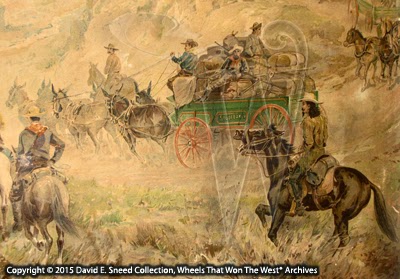“There’s nothing like a nice piece of hickory…” So remarked Clint Eastwood after using an axe handle to put the hurt on four bad guys during one of the opening scenes of the movie, “Pale Rider.” The tongue-in-cheek delivery reinforced the dependability, strength, resilience – and well, uh, ‘versatility’ of hickory wood. Today, we can find hickory used for a multitude of purposes. It’s a staple in everything from smoking meats to making furniture, tool handles, golf clubs, flooring, ladders and much more.
 |
| This early promotional graphic shows six mules pulling a heavily-laden, Studebaker Mountain Wagon. |
In the days when horseflesh ruled the road, hickory was also among the most prized timber for constructing vehicles. The density, muscle, and shock resistance made it an ideal choice for axles. However, while this particular hardwood was extremely popular, it was far from being the only variety used. Early builders blended different types of wood in the construction of almost every set of wheels. The purpose was to obtain optimum performance and durability for each part of a vehicle’s design without adding unnecessary weight. Below, I’ve dissected many of the major areas within a wagon’s construction, sharing the types of wood usedin each. The list is not all-inclusive as there were substitutions for almost everything. That said, these details will cover many of the most preferred timber choices...
- Wooden axles were commonly made of hickory. Some designs might employ maple, pecan, or rock elm but hickory was clearly the favorite.
- The felloes or rims in a wooden wheel were often made from white oak or bois d’arc (sometimes referred to as Osage Orange).
- Hubs were made from seasoned black birch, white oak, or black locust with gum also known to have been used.
- Spokes were often made of hickory or white oak.
- Bolsters were fashioned from white oak or maple.
- Hounds could be white oak or hickory.
- Other parts of the gear, such as the sandboard and reach, were taken from butt cuts of white oak.
- Doubletrees,singletrees, and neck yokes were frequently built out of hickory or white oak.
- Tongues were commonly produced from white oak or ash.
Aside from the running gear elements shown above, farm wagon boxes were also comprised of a mix of different woods. Hardwood provided added strength while softer woods were selected for a combination of strength and lighter weight. Poplar or cottonwood were regular picks for sideboards and end gates while fir was a common choice for some West coast manufacturers. Tongue-in-groove floors were frequently built out of long leaf yellow pine. Cross sills below the box were usually oak hardwood as were the straddler staples and sideboard cleats.
The types of wood used might also be determined by the vehicle style and purpose as well as the timber’s availability and affordability during a given timeframe. As I’ve shared in so many venues over the last two decades, the make-up of America’s early horse drawn vehicles involved a complex collaboration of art, science, personal preference, and know-how.
Just as Eastwood’s character recognized the value of hickory wood, wagon makers, likewise, paid close attention to what they put into their vehicles. Every part of a quality brand was designed to optimize the form, function, and overall satisfaction of a particular set of wheels.
Please Note: As with each of our blog writings, all imagery and text is copyrighted and may not be broadcast, published, rewritten, or redistributed without prior written permission from David E. Sneed, Wheels That Won The West® Archives.
Please Note: As with each of our blog writings, all imagery and text is copyrighted and may not be broadcast, published, rewritten, or redistributed without prior written permission from David E. Sneed, Wheels That Won The West® Archives.